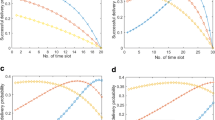Abstract
Recently, many researches focusing on peer-triggered asynchronous protocols have been developed and enhanced since receiver-initiated MAC was designed. Because this approach has fundamental advantage of energy efficiency in high contention environment, the standard amendment document of IEEE 802.15.4e employed this as a new key feature named of Receiver-Initiated Transmission (RIT) operation, as one of non-beacon operations. This new feature of the above standard technology can help to reduce the energy consumption for idle listening from sending device by cutting off the preamble sampling which was necessarily required on LPL-based asynchronous protocol, hence it can mitigate contentions derived from preamble sampling process of sending device on high traffic environment. Even though many researches have tried to analyze the performance evaluation of traditional features on IEEE 802.15.4, this emerging RIT operation has not been analyzed until now. Now we proposed an analytic model based on combining Markov model and Poisson process, and analyze the results with experiment.














Similar content being viewed by others
References
IEEE Standard 802.15.4 (2011). Wireless medium access control (MAC) and physical layer (PHY) specifications for low-rate wireless personal area networks (WPANs). In IEEE standard for information technology.
Bluetooth core specification 4.2, Bluetooth SIG, Dec. 2014.
IEEE Standard 802.15.4 g (2012). Part 15.4: Wireless LAN medium access control (MAC) and physical layer (PHY) specifications for low-rate wireless personal area networks (WPANs), amendment 3: Physical layer (PHY) specifications for low-data-rate, wireless, smart metering utility networks. In IEEE standard for information technology.
IEEE Standard 802.15.4e (2012). Part 15.4: Wireless LAN medium access control (MAC) and physical layer (PHY) specifications for low-rate wireless personal area networks (WPANs), amendment 1: MAC sublayer. In IEEE standard for information technology.
Ye, W., Heidemann, J., & Estrin, D. (2002). An energy-dfficient MAC protocol for wireless sensor networks. In IEEE INFOCOM (pp. 1567–1576).
van Dam, T., & Langendoen, K. (2003). An adaptive energy-efficient MAC protocol for wireless sensor networks. In SenSys (pp. 171–180).
Sun, Y., Du, S., Gurewitz, O., & Johnson, D. B. (2008). DW-MAC: A low latency, energy efficient demand-wakeup MAC protocol for wireless sensor networks. In MobiHoc (pp. 53–62).
Polastre, J., Hill, J., & Culler, D. (2004). Versatile low power media access for wireless sensor networks. In SenSys.
El-Hoiydi, A., & Decotignie, J.-D. (2004). WiseMAC: An ultra low power MAC protocol for multi-hop wireless sensor networks. 9th International Symposium on Computers and Communications (ISCC), 1, 244–251.
Buettner, M., Yee, G. V., Anderson, E., & Han, R. (2006). X-MAC: A short preamble MAC protocol for duty-cycled wireless sensor networks. In SenSys (pp. 307–320).
Sun, Y., Gurewitz, O., & Johnson, D. B. (2008). RI-MAC: A receiver-initiated asynchronous duty cycle MAC protocol for dynamic traffic loads in wireless sensor networks. In SenSys (pp. 1–14).
Tang, L., Sun, Y., Gurewitz, O., & Johnson, D. B. (2011). PW-MAC: An energy-efficient predictive-wakeup MAC protocol for wireless sensor networks. In INFOCOM (pp. 1305–1313).
Park, P., Di. P., Marco, P. & Soldati et al., (2009). A generalized Markov chain model for effective analysis of slotted IEEE 802.15.4. In Proceedings of 2009 IEEE 6th international conference on Mobile Adhoc and Sensor Systems (MASS) (pp. 130–139).
Park, T., Kim, T., Choi, J., Choi, S., & Kwon, W. (2009). Throughput and energy consumption analysis of IEEE 802.15.4 slotted CSMA-CA. Electronics Letters, 41(18), 1017–1019.
Chen, M., Gonzalez, S., Vasilakos, A., Cao, H., et al. (2011). Body area networks: A survey. ACM/Springer Mobile Networks and Applications, 16(2), 171–193.
Kim, T., Park, J., Chong, H., et al. (2008). Performance analysis of IEEE 802.15.4 non-beacon mode with the unslotted CSMA/CA. IEEE Communication Letters, 12(4), 238–240.
Bianchi, G. (2000). Performance analysis of the IEEE 802.11 distributed coordination function. IEEE Journal on Selected Areas in Communications, 18(3), 535–547.
Wireless LAN Medium Access Control and Physical Layer Specifications. In IEEE standard for information technology, 2012.
Malone, M., Duffy, K., & Leith, D. (2007). Modeling the 802.11 distributed coordination function in non-saturated heterogeneous conditions. IEEE/ACM Transactions on Networks, 15(1), 159–172.
Ramachandran, I., Das, A. K., & Roy, S. (2007). Analysis of the contention access period of IEEE 802.15.4 MAC. ACM Transactions on Sensor Networks, 3(1), 4.
Shu, F., Sakurai, T., Zukerman, M., & Vu, H. L. (2007). Packet loss analysis of the IEEE 802.15.4 MAC without acknowledgments. IEEE Communications Letters, 11(1), 79–81.
Zigbee Specification, In Zigbee Alliance Inc., Sept. 2012.
Yang, D. et al. (2010). RW-MAC: An asynchronous receiver-initiated ultra low power MAC protocol for Wireless Sensor Networks. In Wireless Sensor Network, 2010. IET-WSN. IET International Conference on. IET.
Author information
Authors and Affiliations
Corresponding author
Rights and permissions
About this article
Cite this article
Lee, J. An Analysis Model for Performance Evaluations of Peer-Triggered Asynchronous MAC Protocol without Preamble Sampling. Wireless Pers Commun 97, 6265–6285 (2017). https://doi.org/10.1007/s11277-017-4837-4
Published:
Issue Date:
DOI: https://doi.org/10.1007/s11277-017-4837-4




